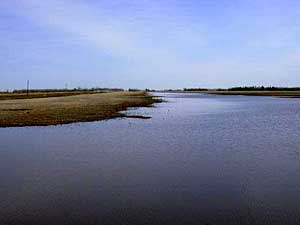|
Audio
Photos
More from MPR
Resources
Your Voice
|
Officials test waffle plan for flood control
April 14, 2004
For years residents of the Red River Valley have struggled with floods. Cities and towns have spent millions of dollars building dikes and diversion projects in an attempt to stay dry. Now researchers are working on a new approach to flood protection. Officials at the Energy and Environmental Research Center in Grand Forks, North Dakota, are testing a program they think will help.
Moorhead, Minn. — It's called the Waffle Plan. Supporters say the idea is simple -- get enough land to create a grid of pockets. But instead of syrup, the land will temporarily hold water. Existing roads and ditches already provide much of the grid needed for the waffle.
"It will control water, instead allowing water to move -- in a sense -- randomly, as fast as it can," says Gerald Groenewold, director of the Energy and Environmental Research Center. "Which is significantly enhanced these days, by, I believe on the Minnesota side, 28,000 miles of certified drainage ditches."
 | |||
Those drainage ditches move water off farm fields and into the Red River. The problem is the water moves too fast. Groenwold says slowing the flow of water into the river lets officials control the river level. A series of culverts and drains will release water only when it will not cause a flood.
The next big hurdle is to convince farmers to allow part of their land to be part of the waffle -- and let water be stored temporarily on their land.
Field tests are being done on a one-square-mile section of land near Shelly, in northwest Minnesota. Field tests here will determine the effects of storing water on the land.
Bethany Bolles, the research manager for the project, believes the field tests will show flood protection is just one benefit of the Waffle Plan.
 | |||
"There will be less sedimentation in ditches. It will keep the sediment on the land, allowing less to run off into the surrounding ditches, and thereby actually helping to improve water quality," says Bolles. A lot of nutrients like phosphorus are attached or adhere to sediment particles. So you can keep that from entering your ditches and ultimately your streams."
The U.S. Department of Agriculture is funding research on the Waffle Plan, which will cost $4.8 million. That pricetag has raised a few eyebrows. Jerry Bennett, who heads the Wild Rice Watershed district, says the money could be spent on other flood prevention efforts.
"Levees for communities, ring levees for farmsteads," Bennett cites as examples. "There's been a number of homes that were devastated by the 1997 and 2000 flood events, that we worked with those residents to help them relocate out of the floodway."
Bennett believes traditional flood protection methods are best. He's skeptical enough farmers will agree to have their land used for the waffle, because holding the water could delay spring planting.
 | |||
But others find the idea intriguing.
Sixty miles northwest of the Shelly test site, near Gilby, North Dakota, is the Scott family farm. John Scott drives his pickup down a dirt road, and points to one of his fields. He says the land is perfect for the Waffle Plan.
"It's very saline. We call it alkaline, but it's actually saline," says Scott. "It'll never be farmed again, I don't think."
Scott says over the years, development of the area has altered the way water drains in the basin, because roads and farms have disrupted the natural drainage flows. He believes the Waffle Plan is a way to mimic those flows.
Scott says the biggest challenge to the Waffle Plan is getting people to change the way they think. He says the idea of protecting people and property with levees and dikes is ingrained in many valley residents.
"I've read philosophers, especially agricultural people. They say, if you've been doing it the same for 20 years, you've been doing it wrong," Scott says.
Researchers hope to have results from this year's field test in a couple weeks. Another test covering more land is planned for spring 2005.
|
News Headlines
|
Related Subjects
|

